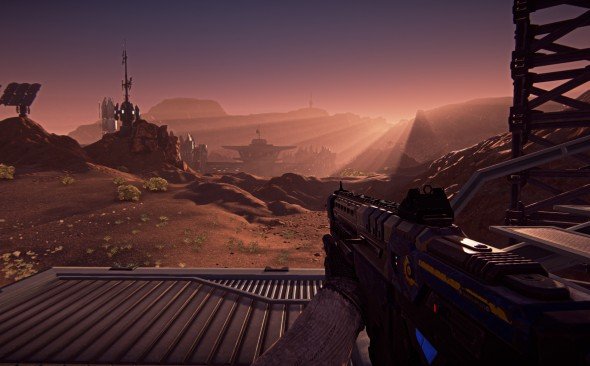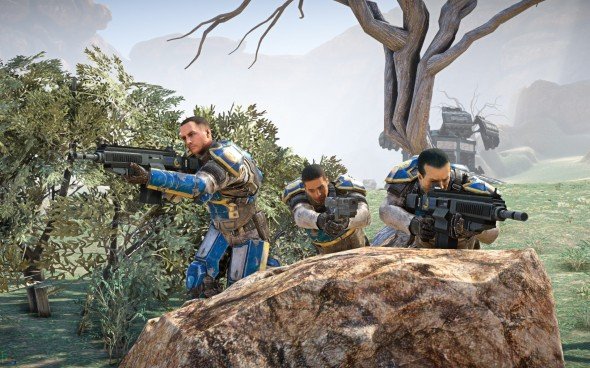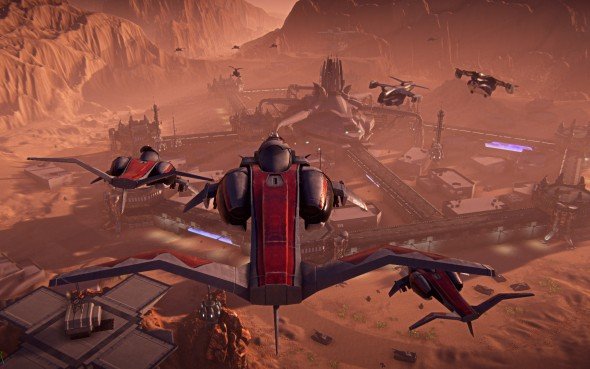Planetside 2 preview

“The impact of weapons needs to be felt not just by the guy getting shot but also by the guy who's doing the firing,” Matt says. “I think that gets missed a lot. There's a lot that goes into it – audio, animation, ambient effects on the screen. In MMOs you don't usually spend a lot of time trying to think about what it feels to cast a spell in first-person – you look at the effect of the spell on the person who's getting hit. But we're an FPS first, and we're always striving to be the best possible FPS we can be.”
There's another hurdle: the game has to feel fair, despite the MMO-style character advancement and the customisation system for its six classes, along with their many weapons and vehicles. Not to mention the distinct tactical and strategic difference enforced by your choice of faction. It's one hell of a balancing act, but Matt's keen that new or non-paying players never feel they are outclassed in battle by the equipment of their veteran foes. You don't pay for power in PlanetSide 2. Mictrotransaction upgrades simply re-specialise your class, or unlock different combat options, all of which are available through playing the game and queuing up skills to be trained passively over time: much as players already do in EVE Online.
“You can really spec out in different ways,” Matt says. “You can spec out the Infiltrator class to be a really sneaky gadgety, sabotage-focused guy, and bring a bunch of C4 and motion detectors and sneak behind enemy lines, stab people and blow up their tanks. Or you could spec him to be a dedicated wilderness sniper character.

“We have six different infantry classes,” Matt continues, as he uses a debug command to unlock the camera, swooping in on character models to show the astonishing, and quite possibly needless, level of detail.
“Light assault is basically the 'glass cannon' character. He can do the most damage the quickest. He's very agile, but it's also very vulnerable. Because he can get to places very quickly, he can overextend himself very easily and if he doesn't have support backing him up he can get crushed.” Matt moves the camera along. “This is our engineer. He can place barriers and gun turrets, and repair vehicles. But he can do a lot of offensive stuff on top of that. Our gun turrets aren't automated, they require a player to actually man them. And then the engineer can go throw mines down and destroy vehicles
“Our heavy assault character again has a dualistic role: he can either be very much an anti-infantry character or very much an anti-vehicle character. You can go play a medic and not really focus on being a combatant, but medics can be very much an in-your-face infantry fighter, too. MAX [mechsuited soldiers] are definitely making a comeback. Unlike PlanetSide 1 where there was a specific MAX for each role, our MAX is configurable, so that you can put an anti-infantry weapon on one arm and an anti-vehicle weapon on another arm. Like everything else we're allowing for a really wide range of customisation with each one of these classes.”
You're never class-locked in PlanetSide 2, either. Equipment terminals let you leap instantly into another class's skin, and then there are the vehicles too, which the devs essentially treat as extra classes. They're just as customisable: a Mosquito can be loaded-out for aerial combat, or air-to-ground as the situation demands.
The biggest gaming news, reviews and hardware deals
Keep up to date with the most important stories and the best deals, as picked by the PC Gamer team.

Some of this customisation comes from the equipment and weaponry – guns are modular and nearly every bit can be swapped out and replaced, altering the weapon's range, rate of fire, sound, scope, capacity, or even the shape of its muzzle flash, while rebalancing other variables to ensure no all-round advantage. But a lot of a player's abilities also come from skills they can train or buy – certificates to use vehicles and aircraft are an obvious one, but there are also more subtle boons: an ability to allow players to spawn on you as squad leader, or inside your dropship. Every compartment of the game has its own skill-tree, it seems, from pilots to squad leaders, commanders and the factions themselves.
The scale of the world, and the battles in it, is breathtaking enough. But the challenge of balancing the complex weave of variables, and fitting it all into a robust MMO social framework, is as colossal a task as you are likely to see in game development. This could be why there aren't that many open-world MMOFPS knocking about. The reason that SOE have done it, and no one else, comes down to the gradual accumulation of tech and expertise over the eight years since PlanetSide 1. During that time they've developed and iterated upon Forge Light – a suite of backend magic that not only spits out PlanetSide 2's dizzying landscapes and player numbers, but also holds together the servers and communication infrastructure of the game.
Despite this technology on hand, PlanetSide 2 remains a huge undertaking, but one that SOE hope will be pay off over many years – after all, PlanetSide 1's servers still ring to the sound of gunfire today, nearly a decade after release. The developers have a huge number of features they plan to add to the game, post-release, from the ability for players to drop and construct their own bases, to the addition of AI wildlife, or possibly an AI faction. All of which will be decided with a good deal of consultation with the players themselves. For all its stunning draw distances and vast landscapes swarming with legion after legion of soldiers, PlanetSide 2 isn't just about a being a big game, it's all about the long game too.

